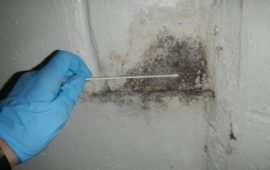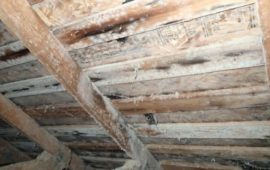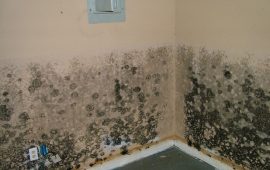Is your house infested with mold? You may not be able to detect it visually since mold is not always present in open spaces. It usually occupies hidden nooks and crannies, staying out of sight until it grows larger and presents more challenges to the homeowner. Mold smell is the telltale signs of mold infestation …
Mold
Mold is a kind of fungus that feeds on moisture and grows anyplace where it is damp or where there is decaying matter. Mold is also commonly known as Mildew. Mold by itself is not toxic, but it can become poisonous when it develops toxins, usually mycotoxins, and this is when it becomes toxic mold.
Mold is a fungus that is found everywhere, in all parts of the world, is characterized by green, orange, blue, or black patches around your home or workplace. Mold is found in the air indoors as well as outdoors. The airborne mold spores can come into homes through windows and doorways. They can also enter homes through ventilation systems, air conditioning ducts, heating systems, or any kind of system that involves intake of outdoor air.
Some of the signs of toxic mold around your home or workplace include:
- Stains on the ceilings and walls are a very common sign that indicates the presence of mold. These stains are usually blue, black, or green in color.
- If your home has a musty odor, or a lingering scent of urine, which cannot be explained, then it could be due to mold.
- Having allergies that refuse to go away despite treatment can be a sign of mold. Toxic Mold contains allergens that are known to cause allergies in people and also various other illnesses.
- Brown, orange, or green spots and specks are also a sign of mold infestation, especially around tiles and plumbing grouts.
There are also certain ways of handling and treating toxic mold once it has been identified, and early action is vital in order to avoid possible harm from the mold. Some of the steps that you should take include:
- Locate the mold: If you see any signs of mold in your home, toxic mold or otherwise, it is necessary to locate all the areas where any type of mold may be present. Places where mold is most likely to grow are wet basements, attics where there is a problem of a leaky roof, ceilings and walls due to leaky pipes, moist carpeting, behind and on wallpaper, and all kinds of wood products.
- Contain the mold: Once you have located the areas where mold grows, you need to contain the growth of toxic mold and stop it from spreading to unaffected areas. Mold needs moisture to grow, so you should try and stop its supply of moisture. Fix all leaky pipes and taps and ensure that there is no seepage of water behind your walls or in bathrooms.
- Kill and remove the mold: Toxic mold is a living organism and has to be killed to be destroyed. Spraying and fogging with mold destroying sprays is a good way to kill mold. Once the mold is destroyed, you have to remove the dead mold as even that can cause health problems. The area from where the mold is removed should be thoroughly dried and all supplies used to clean the toxic mold should be discarded.
Dealing with toxic mold problems can be difficult, and some people do not know enough about toxic mold to know whether they have been affected by this problem. However, this mold can affect your health and your environment, and in many cases can lead to legal recourse, so it is advisable to find out as much as possible.
This site aims to provide details on various areas of toxic mold, from the signs and symptoms to legal information. You can find articles such as:
This is a general overview of toxic mold, describing what it is, where it can be found, how it comes about, how it can be identified, what the effects might be, and what steps to take to minimize on toxic mold problems.
There are more than 100,000 types and species of mold, some of which are harmless, and some, which can cause serious health problems. The most common categories of mold are discussed in this article with a description of these types.
A very harmful and sometimes deadly type of toxic mold is known as Black Mold. This article looks at this type of mold, how it is formed, and how it can be detected and removed before causing harm.
The toxins produced by toxic mold can cause a lot of diseases, in animals and in humans. These illnesses can range from something as slight as a common cold, but in some cases, could even result in death. This article looks at some of the illnesses and problems that toxic mold can result in.
Legal Aspects of Mold Contamination
Over the years, many different laws have been passed, which protect the rights of people in case of mold contamination. This article looks at some of the legal aspects of mold contamination.
The number of private and commercial toxic mold claims is on the increase, and are often compared to asbestos-related claims in terms of their success. This has become a big issue, and successful claims so far have churned out figures in the multi-millions…
As with many other types of litigation, there are specialist lawyers available to deal with toxic mold claims, and this article looks at why and how it could be of benefit to go through a specialist lawyer in the event that you have been harmed through toxic mold.
This is an easy to reference listing of commonly asked questions, and you will be able to get easy access to these questions and answers in a reader friendly format.
Mold Inspection Cost: Knowing What You Pay For
Mold inspection needs more than a keen eye or sniffing ability. In many cases, what we see is only the tip of an iceberg. The bigger problem, such as structural damage, the type of mold and its health hazard, remain unrevealed without the help of professionals. As soon as you detect the presence of mold, …
Does Vinegar Kill Mold? A Complete Guide to Get Rid and Prevent Mold from Coming Back
Nothing looks more disgusting than the fuzzy, slimy molds lurking in the corner of your rooms. Sometimes you don’t realize when it started. The clusters of fungi suddenly creep on the wall without you even knowing. In a suitable condition, mold can grow and multiply within 24 hours. The worst thing about mold is its …
How to Get Rid of White Mold on Wood, Plants & Basement
When homeowners talk about mold problem, they usually think about dark molds, such as black or green mold. White mold often does not receive the same attention, especially since this mold visually resembles harmless structural phenomena called efflorescence (more on that later). However, serious health risks must still be concerns if you find white mold …
Toxic Mold FAQ
What is mold and where is it found? Mold is a kind of fungus that feeds on moisture and grows anyplace where it is damp or where there is decaying matter. Mold is a fungus that is found everywhere, in all parts of the world, and is not something that is seen only in the …




